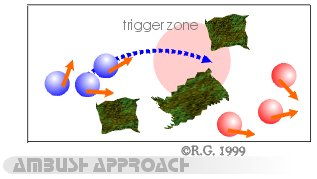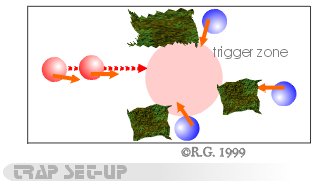 Ambushes/Traps Ambushes/Traps
PREMISE: The art of ambushing the enemy relies on stealth, knowledge
of enemy tactics/location and good group coordination. Traps are the same
as ambushes, but instead of searching for the enemy, one lets the enemy
come into the trap. The advantage to a successful ambush/trap is the element
of surprise. Ambushes/traps do take time and skill to set up, but the completion
of them feels even more rewarding.
AMBUSH 'EM: Before an ambushing run can be attempted, a recon mission
should be run by the recon/scout to assess the enemy's location, armament,
etc. A route to the enemy's location should be chosen which provides a
good deal of cover.
 The
approach should be quick yet silent. One cannot spend to long getting into
position since the enemy's location could change or a patrol group may
spot the oncoming attack. Silence and laying low is vital to a good ambush.
All members of the group should be used to moving quickly while crouching
or perhaps even crawling in some parts. Staying low makes one harder to
see as well as harder to hit. The
approach should be quick yet silent. One cannot spend to long getting into
position since the enemy's location could change or a patrol group may
spot the oncoming attack. Silence and laying low is vital to a good ambush.
All members of the group should be used to moving quickly while crouching
or perhaps even crawling in some parts. Staying low makes one harder to
see as well as harder to hit.
Once within range, the group should attack as a group with everyone
opening fire at a chosen target at the same time. This allows the most
water to be dished out before the enemy has time to react. Shouting or
yelling during the attack also helps disorient the enemy and perhaps even
scare them a little.
POTENTIAL PROBLEMS:
- being spotted on the approach - if spotted, a choice must be made
whether to proceed in the open or retreat, regroup and retry
- no good cover on the route to enemy location - sometimes the terrain
will not allow for a good, stealth approach. In those situations, it may
be better to set up a trap instead
- lots of leaves, twigs, rocks on the ground - this makes it hard
to approach silently. Noise make by walking will alert the enemy and give
away one's location
TRAP/SURPRISE ATTACK: Traps are, in a sense, a form of ambush
but instead of going to the enemy, one lets the enemy come. To set up a
good trap, an area must be chosen which an enemy group is likely to walk
down that provides good cover on both sides for the attackers. Narrow shrub-lined
paths or alleys with multiple recessed doorways are good places to set
up traps.
 All
must be still and quiet while the enemy enters the zone. It is best if
the attackers can see each other or have some method of communicating so
that the trap can be sprung in all directions at once. All
must be still and quiet while the enemy enters the zone. It is best if
the attackers can see each other or have some method of communicating so
that the trap can be sprung in all directions at once.
Once within range, all attackers should open fire at the enemy from
as many directions as possible. The more directions, the less escape routes
the enemy will have to get away. If one can trap the enemy within cross-fire,
it is virtually a guaranteed soak.
MOUSETRAP: Sometimes areas which are good for setting up a trap are
not areas which the enemy is likely to normally go. In those cases, sometimes
a little bait is required to get their attention. One way is to send a
"sacraficial lamb" or person who doesn't mind getting seriously
shot at into the enemy zone once the trap is in place. After spraying the
enemy, the bait person then runs through the trap zone hopefully with many
enemy units in hot pursuit. Once the enemy is within range, let the water
fly! They probably will not expect an ambush and become disoriented by
the attack.
COUNTER-MEASURES: To try and avoid traps, one must not assume anything
and believe that the enemy may be hiding behind any bush, tree, corner,
etc. Also, do not be too quick to persue any gunner into unknown areas.
Ambushes are harder to avoid. The best preventative measure against
ambushes is partols. The partols, however, should try not to follow a typical
pattern so that the enemy cannot time when the patrol will be in any given
place. Setting up alarms/booby-traps around the perimeter of any base or refilling
station will help.

|